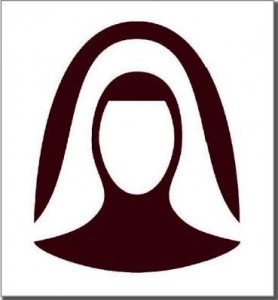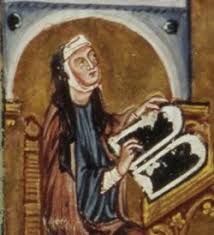
Welcome to my new page, Hildegard of Bingen.
More then 900 years ago in the lush Rhineland Valley of Germany there lived a woman of extraordinary spirit and courage. In a century that gave birth to what has been called the greatest Christian Renaissance, Hildegard of Bingen , whose lifetime spanned eighty per cent of that century (1098 – 1179) stands out.
In her lifetime, Chartres Cathedral rose from the grain fields of France, Eleanor of Aquitane, and Thomas a Becket strode the political stage. Frederick Barbarossa frightened peasant and pope alike – and Hildegard dressed him down in a prophetic voice: Bernard of Clairaux both reformed monastic life, assisted Hildegard as a brother monk, and ironically launched the Second Crusade. The Cathedral School of Paris was evolving into the University of Paris and her writings were approved there. Heloise and Abelard fell in love and left their tragic story for generations to ponder. Through all this Hildegard carried out her work of writing, composing, healing, studying teaching, cajoling and prophesying.
This is the back ground of Hildegard.

SYNOPSIS
A poetic journey – Hildegard of Bingen, 12th century Renaissance, Germany.
One woman’s fierce determination to fulfil her destiny against the patriarchy and power of her beloved Church.
The Prologue has Hildegard, in her eighty-second year, disguising where she has allowed an excommunicant to be buried. The local clergy are furious at this challenge against their authority.
We flash back to a young, excited Hildegard (14) accompanying her mentor, Jutta, (21) to the Disibodenberg Monastery. They accept a nailed in cell, (anchorage) where they live, enclosed, for the next 20 years. Hildegard forges her way with the arrival of new sisters, into a convent with garden and infirmary to become one of the first women writers and musicians of the western world and ultimately Abbess of her own Abbey.
We observe her diplomatic and at times insightful albeit shrewd, moves to get her way in a strictly patriarchal world.
At forty two, she is permitted to write down her visions despite the dictum ‘women must remain silent’. Papal Approval of her writings is a cornerstone of her power.
A climax comes when Hildegard asks to establish an independent Abbey for her women. Abbott Kuno refuses, for the monastery receives much revenue, from the presence of the sisters.
Hildegard takes to her bed and is close to death. The situation escalates when Abbott Kuno declares death will enhance her fame and hence revenue to their monastery.
The monk Volmar, her scribe, fearful for her life informs the Bishop. The Bishop discerns, it is against God’s Will not to finish her Divinely inspired writings. He demands Abbott Kuno release her. Hildegard rises from her ‘death bed’ and leaves the monastery, her home of forty-eight years.
She leads twenty-three sisters to the abandoned Hermitage of St Rupert close to Bingen on the Rhine. Over the next three and a half decades, the number of sisters increases to over a hundred. The Abbey of St. Rupertsberg is a centre of learning, renowned for her writings, her music, her Infirmary and Apotheke and Scriptorium.
Hildegard is a polymath. The writing of her first book Scivias takes ten years. Many more books follow. The opening of her Church, the performance by the sisters of the Morality Play her first Opera, her poetry, her four Missionary Journeys, her correspondence, the compilation of her music and songs, and establishment of a second convent all meet resistance.
Her achilles’ heel is being a woman. Abbott Kuno refuses to give her sovereignty over her dowries. Later replacement priests are refused. we see her courage and determination as she works with Volmar and her sisters to overcome each barrier.
We see the human, emotional side of Hildegard and her capacity for grief and resilience, in the death of Volmar her confident, and the relocation of her intimate and gifted friend and assistant, Richardis.
In her eightieth decade, the Bishop imposes an interdict on her Abbeys – song, all music and sacraments are forbidden. Defiantly Hildegard gathers her strength and faces this last challenge. She is triumphant once again, My sabre my quill . Her letter to the Bishop puts fear into the gullible, superstitious clergy. In this last year of her life the Interdict is lifted and the Abbeys thrive.
This is the story of how a girl placed in a convent as a tithe to God at age 8, and consecrated at 14 , living with ‘an unlearned woman’ becomes one of the great polymaths of the 2nd Millennium and now, in the 21st century speaks to us with her music, her holistic medicine, cosmology, spiritual and physical knowledge.

